3rd (Ulster) Searchlight Regiment, Royal Artillery
3rd (Ulster) Searchlight Regiment, Royal Artillery later the 4th (Ulster) LAA Regt, was an air defence unit of Britain's part-time force the Supplementary Reserve (later the Territorial Army (TA)). The regiment was formed in 1939 during the increase of international tension following the Munich Conference the year before known as the Munich Crisis. When the regiment was mobilised they served in France before returning to be converted to light anti-aircraft artillery (LAA) and eventually participated in the Invasion of Normandy. After the TA was re-organised and re-instated in 1947, the regiment was reformed into two regiments which were later merged, and after more reductions was reduced to today's 206 (Ulster) Battery Royal Artillery based in Belfast and Coleraine under 105th Regiment Royal Artillery.
| 3rd (Ulster) S/L Regt 4th (Ulster) LAA Regt 247th (Ulster) LAA Regt & 248th (Ulster) LAA Regt | |
|---|---|
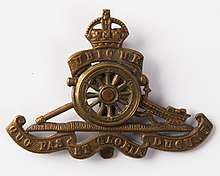 Cap badge of the Royal Artillery under King George VI | |
| Active | 1939—1946 1947—1955 |
| Country | |
| Branch | |
| Type | Anti-aircraft artillery |
| Role | Searchlight/Light Anti-Aircraft artillery |
| Size | Regiment Post War - 2 Regiments |
| Part of | 51st (Ulster) Anti-Aircraft Brigade |
| Regimental Headquarters | Belfast, Northern Ireland |
| Engagements | World War II |
| Commanders | |
| Honorary Colonel | Sir George Ernest Clark, 2nd Baronet |
World War II
Origins
On 1 September 1939 the 3rd Searchlight Regiment, Royal Artillery (Supplementary Reserve) was formed as one of the first Royal Artillery Supplementary Reserve regiments in Northern Ireland along with the 8th (Belfast) Heavy Anti-Aircraft Regiment, Royal Artillery formed just a few months before. Although designated as a Royal Artillery unit, it was still cap-badged and maned by the Royal Engineers.[1][2][3][4][5][6] The regiment had the following structure following their formation;[1][4][7][8][9][10]
- Regimental Headquarters, No.1 Embankment, Sunnyside Street, Belfast
- Regimental Band & Pipes and Drums (acting as stretcher bearers)
- 9th Searchlight Battery (S/L Bty), Clonavar Parck, Strandtown
- 10th & 11th S/L Btys, No.1 Embankment, Sunnyside Street, Belfast
- 12th S/L Bty, Lurgan
Mobilisation
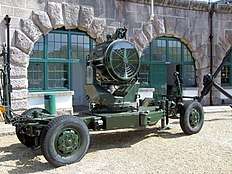
In September 1939 following the announcement for general mobilisation, the regiment was assigned to the 3rd Anti-Aircraft Brigade and consolidated at war stations. They were then preparing their regular home defence role, in addition to working in participation with the local 8th (Belfast), 9th (Londonderry) and 102nd (Ulster) Heavy AA regiments. In October as the British Expeditionary Force (BEF) began forming, the War Office (WO) became increasingly worried by the lack of AA units[Notes 1] assigned to the soon to form BEF. As a result of this, the war office announced the movement of; three HAA (8th (Belfast), 79th (Hertfordshire Yeomanry), and 85th (Tees)), two S/L regiments (2nd (Militia) and 3rd (Ulster)), and one LAA (38th (West Yorkshire)) along with an independent battery attached from the 37th (Tyne Electrical Engineers) S/L Regt, to join the BEF. In November the regiment was assigned to the Home Forces Command, moved to Bordon near Aldershot, and in December moved to France to join the British Expeditionary Force.[1][3][4][11]
Battle of France
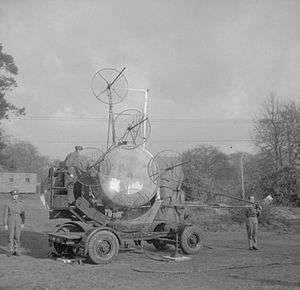
Due to the recent expansion of AA units in France, the 4th and 5th (Searchlight) Anti-Aircraft Brigades' headquarters were moved to France and took control of these newly assigned units. As a result of these moves, the regiment was assigned to the 5th (Searchlight) Anti-Aircraft Brigade along with the 1st (Regular) S/L and 2nd (Militia) S/L regiments. In May 1940 the regiment manned forward gun zones along with their regular colleagues from the 1st and 2nd searchlight regiments, and tasked with defending and supporting the HAA batteries during night raids and assist them when needed[Notes 2]. During this period, the 9th, 10th, and 11th S/L batteries were in the area between Lille and Bethune, while the 12th S/L Bty was in Dunkirk. On 8 May 1940, the regiment was renamed, in accordance with the re-organisation of the Royal Artillery, to become the 3rd (Ulster) Searchlight Regiment, RA (SR) to distinguish itself as a SR unit as apposed to the regular regiments based in the area.[1][2][3][5][11][12][13][14]
When the Battle of France and concurrent Invasion of the Low Countries launched, the regiment supported HAA units during their defence against heavy German fighter attacks and took special advantage of illuminating bombers during the night time raids. During the initial attacks on the night of the 10th, Dunkirk was heavily attacked, and the 12th S/L battery was involved by assisting the HAA batteries there with both searchlights and machine-guns. After three days, the Luftwaffe concentrated on attacking the airfields manned by the Royal Air Force's Advanced Air Striking Force which were based in the Somme area. As these attacks increased, the regiment's three batteries based near Lille were separated to the RAF bases in the area, equipped with more machine-guns, and given a duel LAA/ground support role.[14]
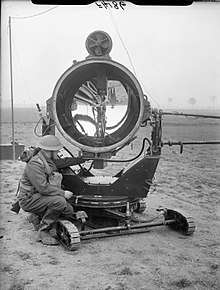
Dunkirk
When the German Army Group B moved through the Ardennes and pushed through the south of the BEF, 9th S/L battery was rushed to Arras to defend the area by digging-in and defending its perimeter. By the time of the push in the south, the regiment was scattered from Vimy Ridge to Arras, but on 19 May was order back to Dunkirk in independent groups as part of Operation Dynamo. The cumbersome 150cm Searchlights were abandoned and disabled as there was no means of bringing them back in time due to the rapidness of the German advance. By 21 May the 9th, 10th, and 11th S/L batteries were finally moved into the city of Dunkirk where the 12th had been based since moving to France. Except for the 12th, the batteries helped the infantry for defence of the city except for a small group which provided a rear guard. By 27 May, the 9th, 10th, and 11th S/L were all moved to the beaches in preparation for their evacuation while the 12th battery was still engaged in air defence duties.[14][15]
Uxem
The next week became an especially tense period for the regiment. On the 27th the 11th battery was driven back by small arms fire, on the 28th the 10th battery was driven back by tanks and artillery, and then the 11th battery was driven back further by more tanks and a failed French artillery support mission. When the 12th battery was attacked, they moved towards Uxem (north-east of the city) were they were tasked with holding the canal entrance bridge and manned a small number of S/L projectors to illuminate the front against night attacks. During this small engagement with the 12th battery, searchlights were used to project the defensive area on land, and this became the first known example of searchlights being used to support or defend against ground attacks. On the 27th the 9th, 10th, and 11th batteries were relieved by infantry and pulled back to the beaches and in turn destroying their left-over equipment.[14]
Evacuation
On the 27th while the other three (9th, 10th, and 11th batteries) retreated towards the beaches, the fourth (12th) battery was still in the middle of the city manning AA defences, despite being heavily shelled and manning a stubborn resistance. While the other three batteries were being embarked between the 28th-30th, the 12th was ordered to send a detachment[Notes 3] to the border town of Furnes, about ten miles from the Belgian border, to hold it against ground attack. Despite the detachment being less than battery strength, they were able to hold Furnes for 36 hours until a company of the 2nd Battalion Coldstream Guards took over. The battery then moved along the coast back towards Dunkirk where they were evacuated during the late hours of the 31st. During their three weeks of combat, the regiment suffered a fairly small amount of casualties; 28 men killed, 41 wounded, and three taken prisoner.[14]
Battle of Britain

After evacuating from France, the regiment was assigned to home duties and concurrently joined the new 8th Anti-Aircraft Division. The 8th AA division was formed in mid-1940 as part of the expansion of AA Command just after the beginning of the Battle of France and during the Phoney War, and tasked with defending the south coast as far east as Bournemouth. Within the division, the 64th Anti-Aircraft Brigade was formed to control the regiments which were tasked with defending the south-west airfields[Notes 4]. As part of this new brigade, the 2nd (Militia), 76th S/L, and 85th S/L[Notes 5] regiments were assigned and tasked along the same lines of the brigade as a result of the increasing bombing from the Luftwaffe.[1][3][16][17][18]
During the Battle of Britain, RAF squadrons based in the south west manned fighters and maritime patrol planes, and tasked to intercept enemy fighters and bombers before reaching the mainland. Among the many bases included some well known ones which proved their worth including; RAF Falmouth, RAF Mount Batten, RAF Exeter, and RAF St Just.[19]
During the later part of 1941, due to manpower over-stuffing and lack of guns available, many searchlight regiments were converted, disbanded, or merged. As a result of these reforms, the number of searchlight units was reduced to just ten batteries. As a result of these re-organisations, on 21 January 1942, the regiment was re-organised and renamed to become the 4th (Ulster) Light Anti-Aircraft Regiment, Royal Artillery. By February the regiment was done converting and assigned again to Home Forces. On 19 June 1942 11th LAA Bty became independent and then joined the 120th LAA Regt soon after.[1][2][3][10][17][20][21]
Following their change in role, the regimental structure was also, altered;[10][21][22][23][24]
- Regimental Headquarters
- 2 Light Air Warning signals teams (utilising the Radar AA No.4 Mk III, manned by Royal Corps of Signals)
- 7th Light Anti-Aircraft Battery (LAA Bty) (utilising 40mm Bofors) (late 9th S/L Bty)
- 8th LAA Bty (late 10th S/L Bty)
- 10th LAA Bty (late 11th S/L Bty)
- 11th LAA Bty (late 12th S/L Bty) - later independent and then moved to 120th LAA Regt, RA
- Light Anti-Aircraft Workshop (LAD), Royal Electrical and Mechanical Engineers (formally Royal Army Ordnance Corps, re-named in Dec. 43 upon formation of the REME)
- Telecommunications maintenance section (attached to workshop when radar were attached)
Operation Overlord
Operation Overlord was the wider name given to the Invasion of Normandy which would eventually end the war in Europe as discussed at the Yalta Conference. This invasion would be spear-headed by the British Army, United States Army, Canadian Army, and forces from many now Nazi controlled nations. Just a few months after the entrance of the United States of America into the war, on the allies' side, the Nazis began construction on the Atlantik Wall which was created in order to be able to hold, or at minimum delay, an enemy landing.[25][26]
When the initial landings in Normandy were launched, the regiment was still based in England, and would join the main forces in mid-June after a beachhead had been established. On 7 and 14 August Operation Totalise and Operation Tractable were launched towards the area of Caen which was key for the Allies to capture if they were to maintain a foothold in the area. During these two operations the regiment participated in the push acting in the ground-support role. During this operation, the regiment was attached to the 2nd Canadian Corps although still remained under administrative command of MGRA[Notes 6], Second Army.[1][20][27]
Brussels 'X' Deployment

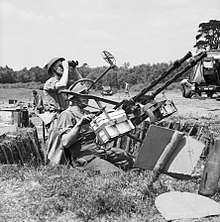
AA Command had plenty of warning that the Germans were developing V-1 flying bombs to use against the UK, and had detailed plans in place (Operation Diver), these plans also covered the strategically important ports of Antwerp (Netherlands) and Brussels (Belgium). These cities provided rear lines of communication and maintained the supply depôts for the 21st Army Group which was preparing to cross the Rhine into the Rhineland and Westphalia. As a result of these increasing threats from the V-1, Operation Diver was put into effect. As far as the mainland Europe theatre was concerned, the allies were to try and take over all, or most, of the launch sites or air bases from which they were launched. Once 21st Army Group had captured Brussels and Antwerp, these cities became targets for V-1s launched from within Germany, and anti-Diver or 'X' defences had to be established.[17][28][29]
After the first V-1s had launched, GHQ[Notes 7] AA Troops launched their plan which deployed the 101st Anti-Aircraft Brigade, which had been stationed in Cherbourg, moved to Brussels in September along with a small vanguard of the Second Army. The 101st AA brigade began deployment on the 12th September with the; 105th HAA, 116th HAA, 4th (Ulster) LAA, and 367th Bty, (from 42nd (7th (Robin Hood) Btn, The Sherwood Foresters S/L Regt) under its command. After arriving in the area of Brussels, the AA defences amounted to; 5 HAA regiments, 2 LAA regiments, and 2 S/L batteries. Brussels at this point was only covered by the British 101 AA Bgd, and Antwerp by the US 50th Anti-Aircraft Artillery Brigade.[30]
To deal not only with conventional air raids but also the threat of V-1 flying bombs (code-named 'Divers'), the planners envisaged a large Gun Defence Area (GDA) integrated into a system ('Brussels X' ) of warning stations and observation posts, supported by radar and searchlights. On 21 October the first bombs were launched against Brussels.[30] The organisation of these posts and lines were organised into three 'lines';[30]
- (1st) Wireless Observation Units (WOUs) line; sited 40 to 50 miles in front of the guns to give eight minutes' warning by radio of a missile's[Notes 8] approach. At first, these covered south-east to east but were extended round to north. WOUs were grouped in fives and each groups had a LW radar manned by the RAF.
- (2nd) Local Warning Stations (LWS) line; in an intermediate zone at about half the distance of the WOUs, each containing one Radar No.4 Mark V and two No.4 Mark IIIs, working in mutual support to track individual missile courses which could be passed to gun positions by way of an AAOR. Four such stations formed a troops, and missile tracks given a code number to identify them for engagement.
- (3rd) An inner belt of observation posts, about 20,000 yards in front of the guns, to give visual confirmation that the tracked target was a missile. Up to 12 such posts were groups as a troop.
Sometime before the end of the year, the regiment was replaced by the 30th (Suffolk) LAA and 73rd LAA regiments. In March 1945 the regiment was moved towards the banks of the Rhine where it divided some batteries to protect the Rhine bridges and crossings.[30][31][32]
Post-war
Following the end of hostilities, by 1946 most territorial artillery regiments had been either disbanded or placed in suspended animation. On 1 January 1947 many of these regiments were reconstituted and many new regiments were formed as part of the reformed and re-organised Territorial Army (TA), with new numbers according to the renumbering plan for the complete re-designation of all Royal Artillery units, both regular and territorial. There were at that time several territorial artillery units still on operational deployments in various theatres overseas. Thus, on 31 December 1946 these regiments were disbanded and then reformed one day after, on 1 January 1947. RHQ & the btys were placed in suspended animation on 1 January 1947 at Lydd Camp, Kent and personnel moved to form new units of the RA with the same numbers. Following reformation the TA regiments of the Royal Artillery adopted a 'standard' organisation which consisted of; RHQ, P, Q, and R Batteries all of which were based in Belfast.[33][34][35]
Following the Royal Artillery's renumbering system, light anti-aircraft regiments were granted numbers between 512 and 558, but due to the regiment being part of the Supplementary Reserve, they were granted a number between 201-255. As a result of this re-organisation, the regiment was re-formed into two regiments numbered as the 247th (Ulster) Light Anti-Aircraft Regiment, Royal Artillery now reformed into the Territorial Army and the 248th (Ulster) Light Anti-Aircraft Regiment, Royal Artillery newly formed and based in Belfast. In 1949 the regiment was re-organised into a mixed searchlight and LAA unit, becoming the 247th (Ulster) Light Anti-Aircraft/Searchlight Regiment, Royal Artillery. Finally, in 1955 following extensive reviews, AA defence (as far as AA guns) was deemed 'obsolete' with the coming of the missile age, so following a War Office decision, all regiments of Anti-Aircraft Command were disbanded or merged/converted. As a result of these re-organisations, the regiment was merged with the other four Northern Ireland AA regiments to form the new 245th (Ulster) Light Anti-Aircraft Regiment, Royal Artillery which was eventually amalgamated with the 445th (Lowland) Light Air Defence Regiment, Royal Artillery to form the 102nd (Ulster & Scottish) Light Air Defence Regiment, which was later reduced to 206 (Ulster) Battery in 1992, which continues to be based in Belfast under the 105th Regiment, Royal Artillery (V).[1][33][35][36][37][38][39][40]
Uniform and honorary colonel
Cap and Collar Badges
The regiment along with all other regiments of the Royal Artillery wore the grenade collar badge and Royal Artillery cannon cap badge on a dark blue beret.[5]
Arm Badge
During the Second World War, the regimental badge was the Red Hand of Ulster on a khaki rectangle.[5][41]
Arm Title
In common with the other regiments of the later 51st (Ulster) Anti-Aircraft Brigade, a supplementary army title ULSTER, embroidered in red and dark blue, was worn on battledress blouses below the Royal Artillery title.[5][41]
Honorary Colonel
The Honorary Colonel of the regiment was Sir George Ernest Clark, 2nd Baronet who held the position from 1939 to 1946.[8]
Footnotes
- Searchlight (S/L) are considered AA along with the HAA, LAA, and MG-AA units
- LAA units controlled some LMGs during this time.
- By this time the battery had been depleted smaller then battery size
- For the South-West airfields see; Airfields, the South West Airfields Hertage Trust
- Formed and assigned in 1941
- Major General Royal Artillery
- General Headquarters
- At this point the term 'missile' wasn't being used, but will be said for simplicity.
Notes
- Litchfield, pp. 310-1.
- Frederick, p. 863.
- 3 (Ulster) Searchlight Regiment RA Archived 2016-03-31 at the Wayback Machine, at the Royal Artillery 1939-45, Archived on 7 January 2009 at the Wayback Machine.
- United Kingdom 1939-40: Northern Ireland District (1939) at British Military History.
- North, pp. 38-9.
- Routledge, p. 66.
- The Patriot Files. British Northern Ireland District on 3 September 1939. Retrieved 25 December 2019
- The Monthly Army List September, 1939, War Office, United Kingdom available at the National Library of Scotland site.
- Frederick, p. 858.
- Frederick, p. 863.
- Routledge, p. 116.
- Routledge, Table XVIII, p. 126.
- Joslen, p. 462.
- Routledge, pp. 121-2.
- Brayley, North-West Europe, pp. 5-6.
- 8 AA Division Archived 2016-03-04 at the Wayback Machine at the Royal Artillery 1939-45, Archived on 4 March 2016 at the Wayback Machine.
- General Sir Frederick A. Pile, Supplement to the London Gazette of Tuesday, the 16th of December, 1947.
- Pettibone, p. 299.
- Jefford, Map 5, pp. 196-7.
- 4 Light AA Regiment RA Archived 2009-01-07 at the Wayback Machine, at the Royal Artillery 1939-45, Archived on 7 January 2009 at the Wayback Machine.
- Anti-Aircraft Command Orbat, May–Oct 1942.
- Dr Leo Niehorster, British, Colonial, and Dominion Armies; Headquarters, Light Antiaircraft Regiment, RA at World War II Armed Forces - Orders of Battle and Organizations.
- Brayley, North Africa, pp. 577, 587.
- 4 LAA Regiment Roll of Honour at Royal Artillery Units Netherlands 1944-1945.
- Brayley, North-West Europe, p. 11.
- Ellis, Volume I, p. 120.
- Joslen, p. 463.
- Routledge, pp. 408-10.
- Collier, Chapter XXIII The Flying Bomb:Part One (1939-1944), pp. 353-65.
- Routledge, p. 336-8.
- Routledge, p. 360.
- Routledge, Table LVII, p. 366
- Litchfield, pp. 5-6.
- Frederick, p. 820.
- Frederick, p. 996.
- Routledge, pp. 441.
- Wienand Drenth & T. F. Mills, 102nd (Ulster and Scottish) Regiment Royal Artillery (Volunteers), at the Land Forces of Britain, the Empire, and Commonwealth, Archived on 9 November 2007 at the Wayback Machine.
- Wienand Drenth & T. F. Mills, 105th Regiment Royal Artillery (Volunteers) Archived 2007-12-18 at the Wayback Machine, at Land Forces of British, the Empire, and Commonwealth, Archived on 9 November 2007 at the Wayback Machine.
- T. F. Mills, The Ulster Gunners, Royal Artillery Archived 2004-08-14 at the Wayback Machine, at Land Forces of Britain, the Empire, and Commonwealth, Archived on 12 October 2007 at the Wayback Machine.
- 105 Regiment Royal Artillery at the British Army website.
- Litchfield, p. 311
References
- J.B.M. Frederick, Lineage Book of British Land Forces 1660–1978, Microform Academic: Wakefield, United Kingdom, 1984, ISBN 1-85117-009-X.
- Normand E. H. Litchfield, The Territorial Artillery 1908 - 1988, 1992: The Sherwood Press, Nottingham, United Kingdom. ISBN 0-9508205-2-0
- Brigadier N. W. Routledge. History of the Royal Regiment of Artillery: Anti-Aircraft Artillery 1914-55. (1994). London, United Kingdom: Brassey's Publishing. ISBN 1-85753-099-3.
- Lieutenant Colonel H. F. Joslen, Orders of Battle Second World War 1939-45, Reprinted by permission of Her Majesty's Stationery Office, Eastbourne, United Kingdom. ISBN 9781843424741.
- Martin Brayley, The British Army 1939-45 (1); North-West Europe - Man-at-Arms Series. 2001: Osprey Publishing, Botley, Oxford, United Kingdom. ISBN 978-1-84176-052-0.
- Martin Brayley, The British Army 1939-45 (2); Middle East & Mediterranean - Men-at-Arms Series. 2002: Osprey Publishing, Botley, Oxford, United Kingdom. ISBN 1-84176-237-7.
- Jonathan North, An illustrated encyclopedia of Uniforms of World War II. 2015: Lorenz Books. ISBN 978-0754829881.
- Charles D. Pettibone, The Organisation and Order of Battle of Militaries in World War II, Volume II; The British Commonwealth. 2006: Trafford Publishing, Victoria, British Columbia, Canada. ISBN 141208567-5.
- Bail Collier, History of the Second World War, United Kingdom Military Series: The Defence of the United Kingdom. 1957: Her Majesty's Stationery Office, London. ISBN 978-1845740559.
- Wing Commander C G Jefford, RAF Squadrons; A Comprehensive Record of the Movement and Equipment of all RAF Squadrons and their Antecendents since 1912. 1988 (Reprinted 1994): Airlife Publishing, Shrewsbury, United Kingdom. ISBN 1-85310-053-6.